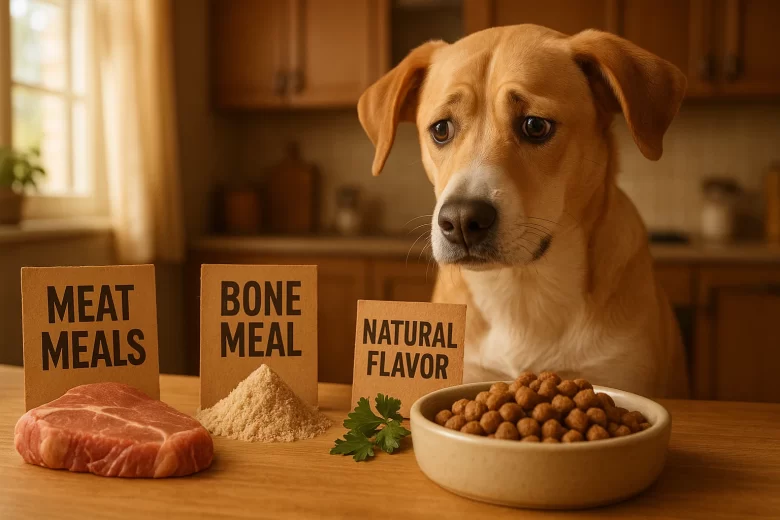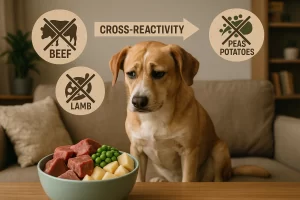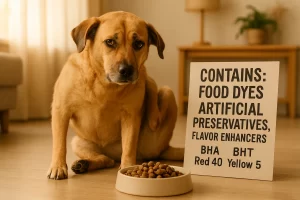As pet owners, we always want our dogs to stay healthy and happy, and one way to do this is by providing them with the right food. However, some dogs can develop food allergies, and finding the right food for them can be a challenge. In some cases, even if the food appears to be allergy-friendly, hidden allergens may still be present in the ingredients. In this article, we will explore the most common food allergens in dogs, how certain ingredients mask them, and how to identify the best food options for your dog’s allergies.
Understanding Food Allergies in Dogs
Food allergies occur when a dog’s immune system reacts negatively to a certain ingredient in their food. The body mistakenly identifies that ingredient as a threat, triggering an immune response. This reaction can cause a range of symptoms, including digestive problems, skin issues, and behavioral changes.
Common food allergens in dogs include proteins like beef, chicken, and lamb, as well as grains like wheat, corn, and soy. The challenge for dog owners is that allergens may not always be easy to identify, as they can sometimes be masked by other ingredients. In this article, we’ll look at how some ingredients disguise harmful allergens and how to ensure your dog is eating a diet that is truly free from allergens.
Most Common Allergens in Dog Food
Before we dive into how certain ingredients mask allergens, let’s first review the most common allergens in dog food:
1. Proteins
Proteins are the most common cause of food allergies in dogs. While many commercial dog foods contain standard proteins like chicken or beef, some dogs may be allergic to these meats. Other proteins, like lamb and turkey, are considered “novel” proteins and are often used in hypoallergenic dog food formulas to avoid common allergens.
2. Grains
Grains like wheat, corn, and soy are common allergens in dogs, especially in processed commercial dog food. Dogs with sensitivities to grains may experience symptoms such as itching, diarrhea, or vomiting. As a result, many dog food manufacturers offer grain-free formulas to cater to dogs with grain sensitivities or allergies.
3. Dairy Products
Dairy is another common allergen for dogs, and many dogs have difficulty digesting lactose, the sugar found in milk. This can lead to gastrointestinal problems, such as diarrhea and bloating.
4. Artificial Additives and Preservatives
Artificial additives, such as colors, flavors, and preservatives, are often included in commercial dog food to enhance taste and shelf life. However, these additives can also be potential allergens for some dogs, leading to adverse reactions such as skin irritations and digestive issues.
Ingredients that Mask Dangerous Allergens in Dog Food
While most commercial dog foods label allergens clearly, some ingredients can disguise the presence of harmful allergens. These ingredients may make it difficult for pet owners to identify the true cause of their dog’s allergic reactions. Below are some common ingredients that can mask allergens in dog food:
1. By-Products
By-products are ingredients derived from the processing of animal meats, and they are often included in lower-quality dog food formulas. These by-products may include organs, bones, or other parts of the animal that are not commonly consumed by humans. While by-products can provide valuable nutrients, they are not always clearly labeled, and some by-products may contain allergens like chicken, beef, or pork that can trigger allergic reactions in sensitive dogs.
Why they mask allergens: By-products do not always specify the source of the protein, making it difficult to determine which specific protein is causing an allergic reaction in your dog.
2. Hydrolyzed Proteins
Hydrolyzed proteins are proteins that have been broken down into smaller components to make them less likely to trigger an allergic reaction. They are often used in hypoallergenic dog food formulas designed for dogs with food sensitivities. However, in some cases, hydrolyzed proteins can still cause allergic reactions, particularly if the dog has a sensitivity to the original protein source.
Why they mask allergens: The process of hydrolyzing proteins may make them less recognizable to the immune system, but they can still contain trace amounts of allergens that could trigger a response in highly sensitive dogs.
3. Natural Flavors
Many dog foods include “natural flavors” to improve taste and appeal to picky eaters. While these flavors are often derived from animal products, they may not be listed in detail on the label, and the exact ingredients are not always disclosed.
Why they mask allergens: The use of natural flavors can hide the presence of potential allergens like chicken, beef, or fish, which may be included as part of the flavoring but are not specifically listed on the ingredient list.
4. Corn and Soy Protein Concentrates
Corn and soy protein concentrates are commonly used in dog food as fillers and sources of protein. While they are often marketed as being suitable for dogs with allergies, they can still cause allergic reactions in some dogs, especially those with sensitivities to corn or soy.
Why they mask allergens: Corn and soy protein concentrates can be used to provide the necessary protein content in dog food, but their presence may mask the presence of other allergens that are not immediately obvious.
5. Meat Meal and Bone Meal
Meat meal and bone meal are common ingredients in many commercial dog foods, and they are often used as a source of protein. However, the labeling of meat and bone meal can be vague, as it does not specify the exact type of meat or animal used in the meal. This lack of specificity can mask the presence of allergens like beef, chicken, or lamb, which may be present in the meal.
Why they mask allergens: Since the specific source of the protein is not always disclosed, it can be difficult for pet owners to determine which allergen is present in the food.
How to Choose the Right Food for Dogs with Allergies
When selecting food for a dog with food allergies, it’s essential to focus on high-quality ingredients that clearly identify the source of protein and other components. Here are some tips for choosing the best food for your dog:
1. Look for Limited Ingredient Diets
Limited ingredient diets (LID) focus on using a minimal number of ingredients, typically one source of protein and one carbohydrate source. These diets are excellent for dogs with allergies because they reduce the chance of exposure to hidden allergens.
2. Choose Novel Protein Sources
If your dog is allergic to common proteins like chicken or beef, consider choosing dog food that contains novel proteins, such as duck, venison, or kangaroo. These proteins are less likely to trigger allergic reactions because they are not typically used in mainstream dog food.
3. Check for Grain-Free Options
If your dog is allergic to grains like wheat or corn, consider switching to a grain-free diet. Many high-quality grain-free dog foods use alternative carbohydrates like sweet potatoes, peas, or lentils, which are less likely to cause allergic reactions.
4. Consult with Your Veterinarian
If you’re unsure which ingredients are triggering your dog’s allergies, consult with your veterinarian. They can help you identify potential allergens and recommend the best diet for your dog’s specific needs.
Conclusion
Food allergies in dogs can be tricky to navigate, especially when certain ingredients mask the presence of dangerous allergens. By being mindful of common allergens like proteins, grains, and artificial additives, and carefully reading ingredient labels, you can help your dog avoid harmful reactions. Choosing high-quality, limited ingredient, or hypoallergenic dog food will make it easier to manage your dog’s allergies and ensure they stay healthy and happy.



